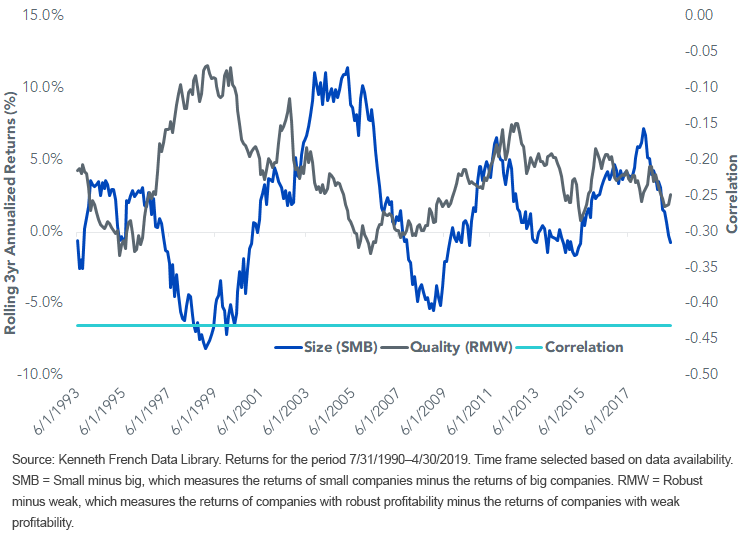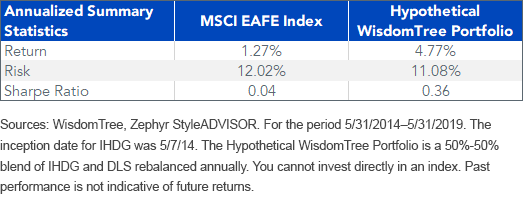International Factor Portfolio: Complementing Premiums


A portfolio of small-cap companies—particularly small value companies—would be expected to outperform a portfolio of larger companies over the long run.
This is a well-known anomaly among investment professionals and academics. It’s commonly referred to as the “size premium.”
Sounds easy enough to beat the market, then, right?
Unfortunately, there are two parts to that first sentence that introduces challenges: “expected to outperform” and “over the long run.”
Expectations are no guarantee, and no one knows how long “the long run” will be. Consider the data for developed ex-U.S. equities, where small caps have handily outperformed large caps in recent years. Over rolling three-year periods back to 1990, the size premium was negative a not-so-insignificant one-third of the time.1
There’s a solution for investors: diversify factor exposures to those that typically perform well when others you are exposed to are doing less well. A factor that pairs particularly well with size is quality.
Inverse Correlation: Quality and Size Factors
The size premium tends to perform best in “risk-on” markets, when investors bid up riskier small-cap companies that are more closely tied to the whims of the business cycle.
Quality tends to performs well during market turbulence, when investors favor companies with high profits and strong balance sheets that are better positioned to withstand a slowdown—just the time when smaller companies are underperforming. Over the past 30 years, the correlation of these two factors in developed ex-U.S. markets has been -0.43.
Fama-French Developed International Factor Premiums

WisdomTree International Quality and Size Indexes
The WisdomTree International SmallCap Dividend Index weights small-cap companies on an annual basis by their cash dividends paid. Positive tilts to both size (0.47) and value (0.13) are evident in regressions on the Fama-French Five-Factor Model.
The WisdomTree International Quality Dividend Growth Index selects 300 companies based on a combination of trailing three-year profitability and future growth expectations. Constituents are weighted by cash dividends paid, tilting the Index toward larger companies that pay greater cash dividends. Again, the factor loadings below help confirm our intuition that the Index offers a high exposure to the quality factor (0.27).
What happens when we blend the two strategies? A hypothetical 50-50 blending resulted in positive and more balanced factor loadings to both size (0.17) and quality (0.17). A similarly constructed portfolio could mitigate the pronounced swings in performance that can result from concentrating on either of these individual factors while still harvesting the outperformance that can come from both.

For definitions of terms in the chart, please visit our glossary.
Conclusion: Multifactor with a 50% Hedge Baseline
Many asset allocators spend their time thinking about their equity exposures and then figure currency exposures will be a wash in the long run. While we don’t know if the currency exposure will be a headwind or tailwind going forward, our research has shown that taking on currency risk within broad international equity allocations has consistently increased risk.
We would advise at least a 50% currency-hedged approach to help mitigate the currency risk of international investing—this way, investors can be shielded from a significant drag if the dollar has a prolonged period of strengthening but have some tailwind of currency returns if the dollar weakens.
From within the WisdomTree family of international equity offerings, we favor a blending of the WisdomTree International Hedged Quality Dividend Growth Fund (IHDG) and the WisdomTree International SmallCap Dividend Fund (DLS) to provide both balanced factor exposures as well as mitigate currency risks with a 50% aggregate hedge ratio. IHDG was designed to track the WisdomTree International Hedged Quality Dividend Growth Index after fees and expenses, which adds a currency hedge to the equity basket of the unhedged WisdomTree International Quality Dividend Growth Index.
Since the inception of IHDG in May 2014, a hypothetical 50-50 blended portfolio of these two funds outperformed the MSCI EAFE Index by 350 basis points (bps) annualized, with just under 100 bps of lower risk.

1Source: Kenneth French Data Library. Returns for the period 6/30/1990–4/30/2019. Measured using rolling three-year returns with quarterly observations.
Important Risks Related to this Article
There are risks associated with investing, including the possible loss of principal. Foreign investing involves special risks, such as risk of loss from currency fluctuation or political or economic uncertainty. To the extent the Fund invests a significant portion of its assets in the securities of companies of a single country or region, it is likely to be impacted by the events or conditions affecting that country or region. Dividends are not guaranteed, and a company currently paying dividends may cease paying dividends at any time. Investments in currency involve additional special risks, such as credit risk and interest rate fluctuations. The Fund invests in derivatives in seeking to obtain a dynamic currency hedge exposure. Derivative investments can be volatile and these investments may be less liquid than other securities, and more sensitive to the effect of varied economic conditions. As this Fund can have a high concentration in some issuers, the Fund can be adversely impacted by changes affecting those issuers. The Fund invests in the securities included in, or representative of, its Index regardless of their investment merit, and the Fund does not attempt to outperform its Index or take defensive positions in declining markets. Due to the investment strategy of this Fund, it may make higher capital gain distributions than other ETFs. This may result in greater share price volatility. The composition of the Index underlying the Fund is heavily dependent on quantitative models and data from one or more third parties, and the Index may not perform as intended. Please read each Fund’s prospectus for specific details regarding the Fund’s risk profile.


